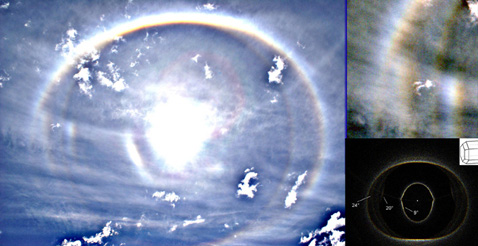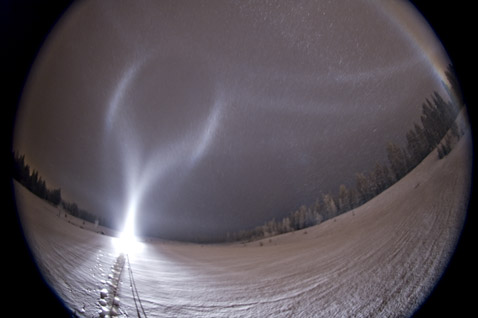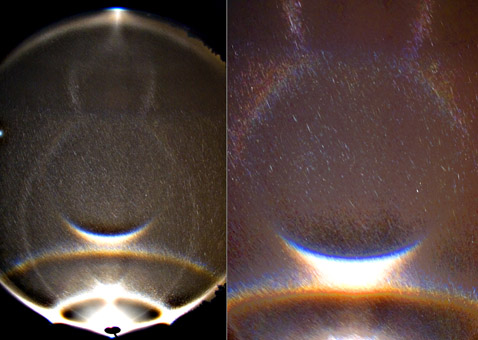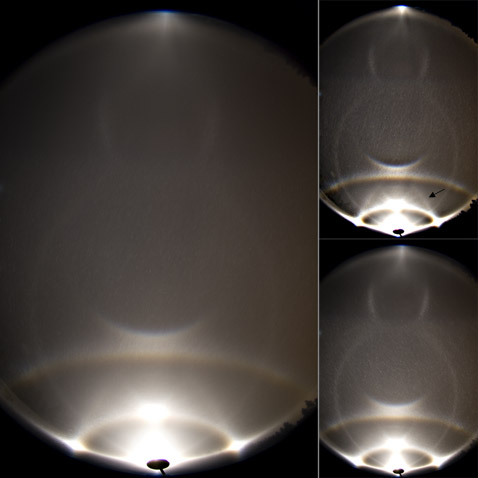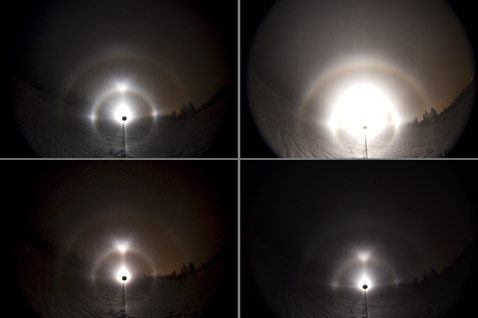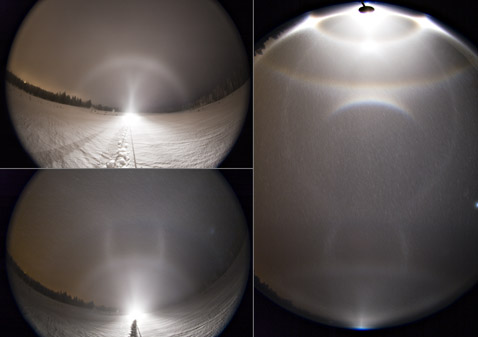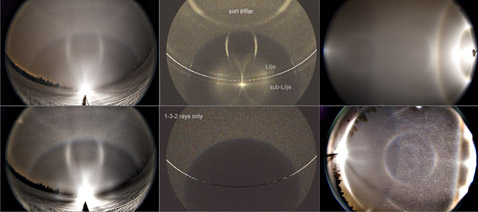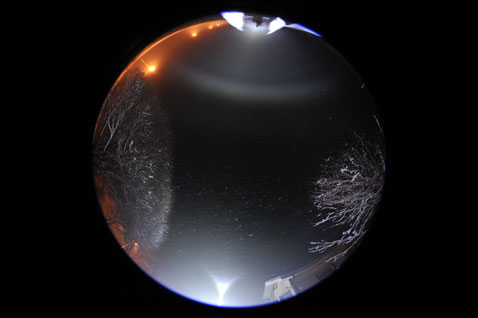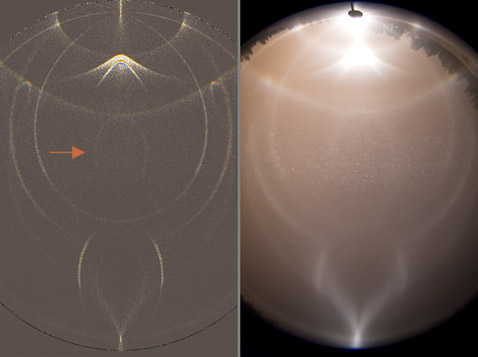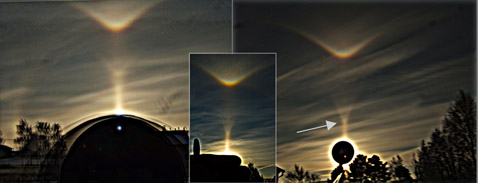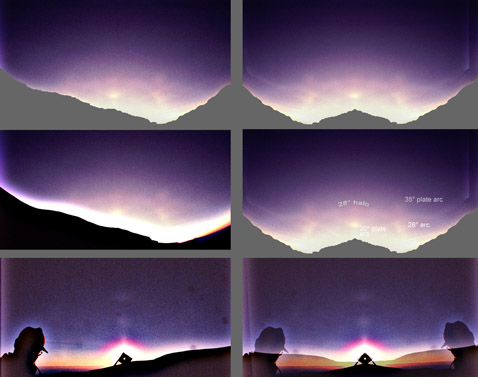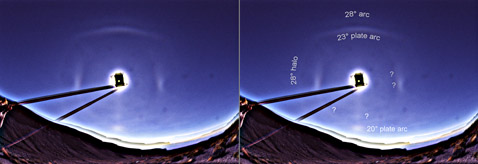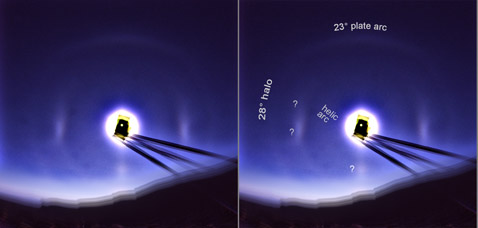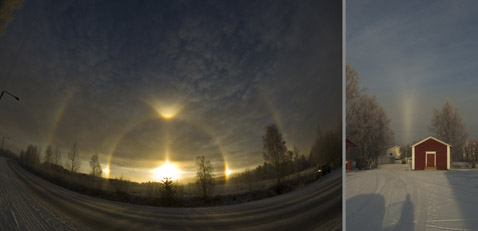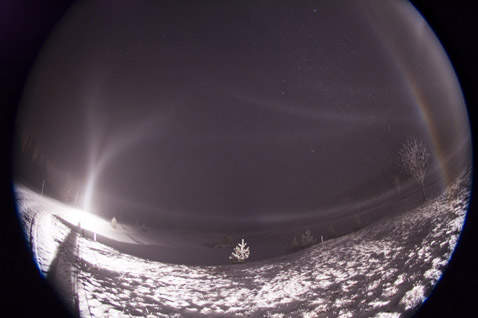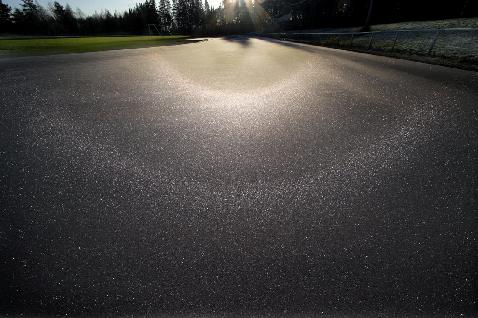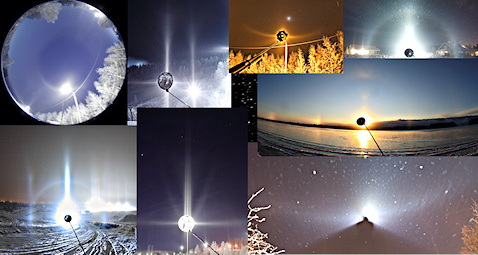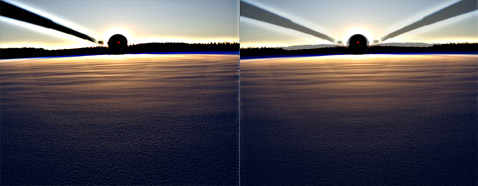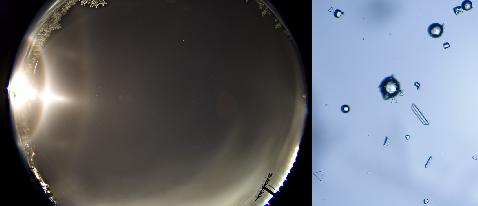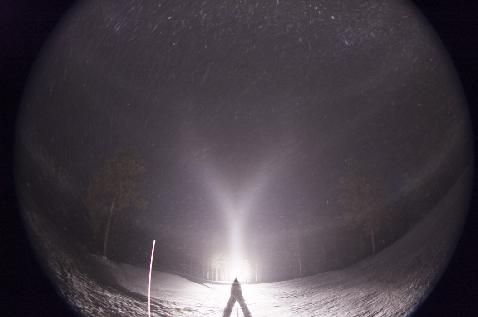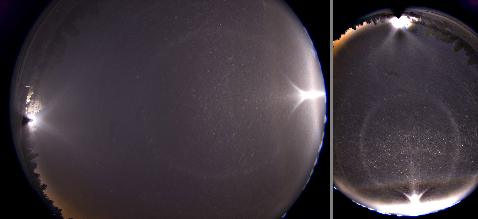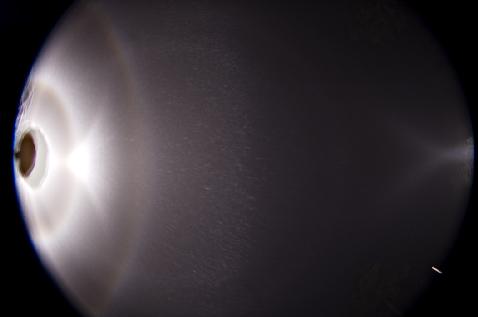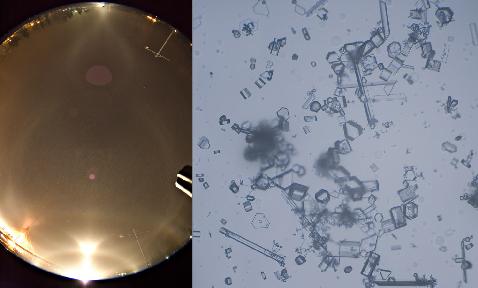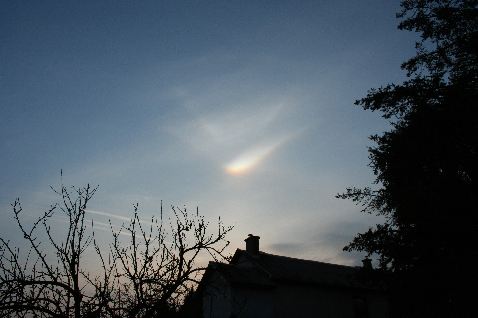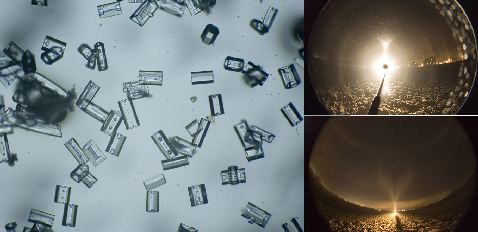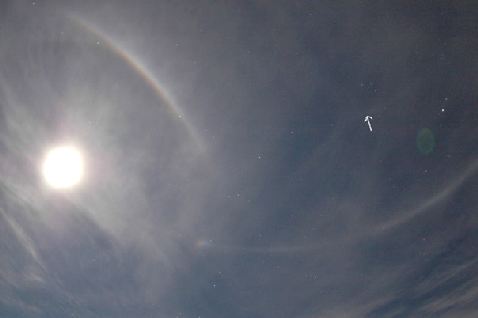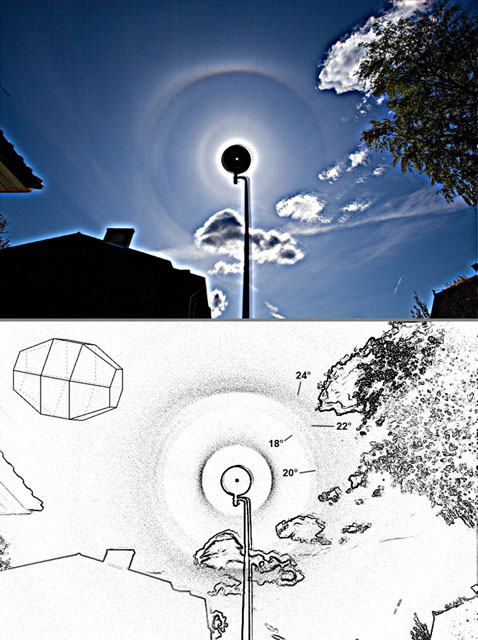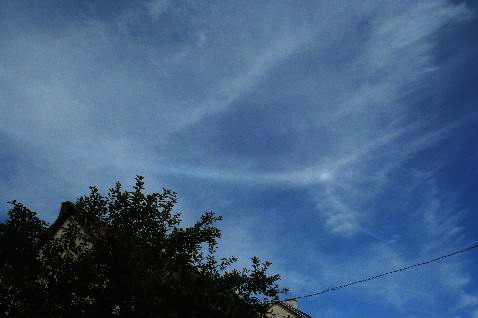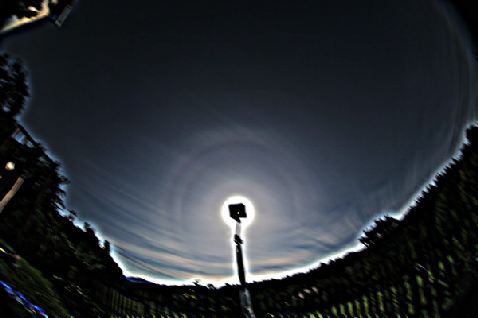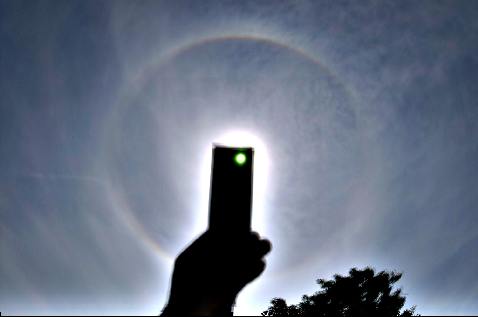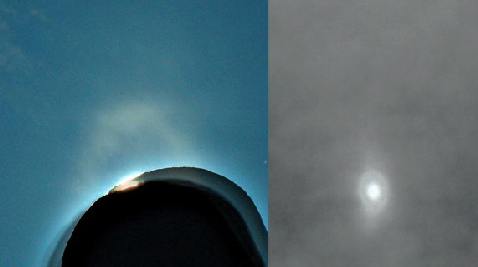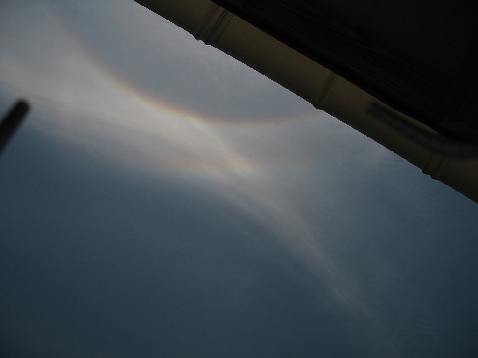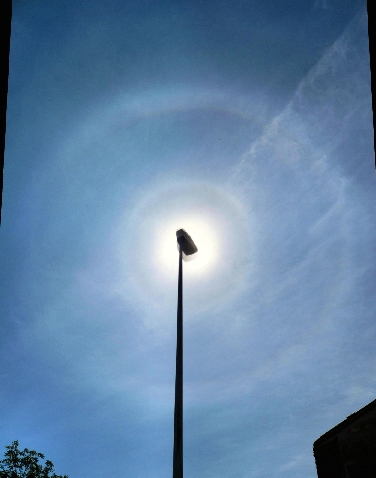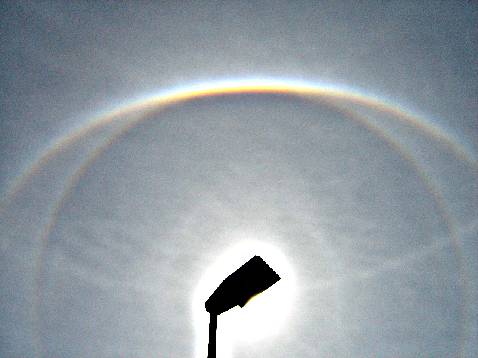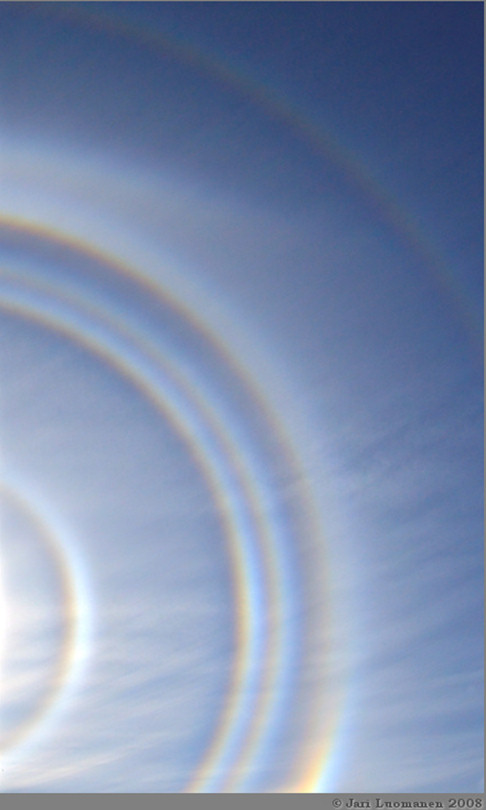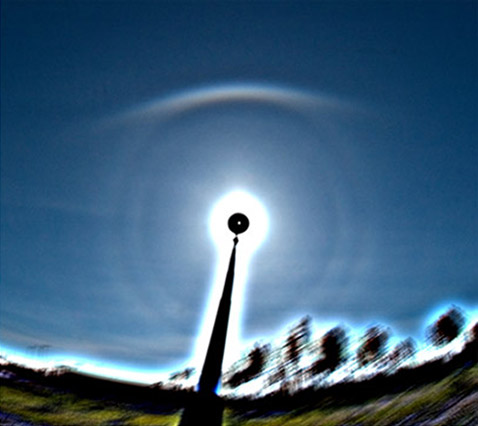2008. december 28., vasárnap
Odd radius column arc display
This display with 24°, 20° and 9° column arcs was observed at 10:47 on 29 June 2008 near Tselinograd by Konstantin Bespalov.
The original photos can be found here: ( 1 - 2 ), and a simulation of this display by Marko Riikonen here: ( 3 ).
2008. december 26., péntek
Effects of crystal swarm density variation in halos
These photos and animation ( 1 ) show rather prominent effects in halos from crystal swarm density variation. Photos are from 7/8 December display in Rovaniemi.
2008. december 25., csütörtök
Reflected Lowitz arcs with crystals

2008. december 24., szerda
Another photo of 7/8 December in Rovaniemi
In this photo of 7/8 December in Rovaniemi there is nothing that we haven't seen before. But ordinary lamp halos are quite well developed, like the subanthelic arc that loops all the way to subanthelic point.
Merry Christmas to all.
Merry Christmas to all.
2008. december 23., kedd
Kern arc on 7/8 December in Rovaniemi
While sub-Kern was strong in the 7/8 December display, the Kern arc was less so. For one thing, I did not see it visually. In the two photos showing it, it can hardly be distinguished from the overlapping heliac arc. The other one of these photos is shown here. On the right is a heavily enhanced version zoomed at the zenith region.
2008. december 21., vasárnap
Reflected Lowitz arcs in 7/8 December display
Two consecutive photos of the 7/8 December display contain reflected Lowitz arcs. The large image above is a stack of these two photos, the small upper image being heavily unsharp masked version of it. Reflected Lowitz arc is marked with an arrow in the small image.
The moment of reflected Lowitz arcs was short lasting: two photos showing them were taken within 35 seconds. Photos taken immediately before or after do not contain them. The lower small photo is timed one minute before their appearance, the halo composition being otherwise similar except for the reflected Lowitz arcs.
In these photos present is also upper sunvex Parry arc, which was missing from the display phase shown in my previous postings.
The moment of reflected Lowitz arcs was short lasting: two photos showing them were taken within 35 seconds. Photos taken immediately before or after do not contain them. The lower small photo is timed one minute before their appearance, the halo composition being otherwise similar except for the reflected Lowitz arcs.
In these photos present is also upper sunvex Parry arc, which was missing from the display phase shown in my previous postings.
Lampside of 7/8 December
Here are photos taken towards the lamp. They were taken at the time when blue circle was strong on the opposite side of the sky. The upper ones are single images, exposure times 2 and 15 seconds. The lower images are stacked from a couple of frames with 1 to 2 seconds exposures.
Simulations say the lamp elevation is pretty close to 5 degrees. Images show upper sunvex Parry but no suncave Parry. Low lamp elevation may alone exclude suncave Parry, but as it is seen in some other photos, changes in crystal prism face ratios must be responsible for this difference. Best simulations of these photos are obtained with Parry crystals that are towards a triangular shape.
Simulations say the lamp elevation is pretty close to 5 degrees. Images show upper sunvex Parry but no suncave Parry. Low lamp elevation may alone exclude suncave Parry, but as it is seen in some other photos, changes in crystal prism face ratios must be responsible for this difference. Best simulations of these photos are obtained with Parry crystals that are towards a triangular shape.
2008. december 19., péntek
Another Bouguer's halo
These three single photos are from different stages of the 7/8 December display in Rovaniemi. They all show Bouguer's halo, i.e. fogbow together with halos. But in reality halos and fogbow were seen mainly separately, in swiftly passing ice and water clouds. 30 seconds exposure has captured them nicely in the same frame.
2008. december 15., hétfő
Circular subanthelic halo from 3-5-6-7-(2)-3 raypath
The subhorizon photos of 7/8 December show what seems to be part of a diffuse circular halo surrounding the subanthelic point. Similar effect can be simulated with random oriented crystals (arrow in the simulation on the left). It arises from raypaths 3-5-6-7-3 and 3-5-6-7-2-3, which in plate crystals make respectively the Liljequist and sub-Liljequist parhelia.
The simulation on the right provides a 180 degree view of halos from random orientation centered around the subanthelic point. The bright dot is the subanthelion. The narrow small radius halo is from raypath that I have not checked. It seems to disappear if the crystals deviate even a little from regular hexagonal shape. Then there is the diffuse 3-5-6-7-(2)-3 subanthelic halo and blue circle.
Finally, a note on the Parry crystals used in the simulation on the left: no triangles this time, regular h/d 1 hexagons were used. Simulations with Jukka Ruoskanen's software.
The simulation on the right provides a 180 degree view of halos from random orientation centered around the subanthelic point. The bright dot is the subanthelion. The narrow small radius halo is from raypath that I have not checked. It seems to disappear if the crystals deviate even a little from regular hexagonal shape. Then there is the diffuse 3-5-6-7-(2)-3 subanthelic halo and blue circle.
Finally, a note on the Parry crystals used in the simulation on the left: no triangles this time, regular h/d 1 hexagons were used. Simulations with Jukka Ruoskanen's software.
Blue circle
What happens when tilts of the crystals that make blue spot increase? The blue spot starts to elongate vertically, forming eventually a blue circle. It is shown in these images that were taken on 7/8 December night in Rovaniemi.
Simulations in the middle used plate crystal tilts of 90 degrees to make blue circle. In the lower simulation the 1-3-2 rays responsible for blue circle are shown (probably also 3-1-6 rays contributed, but they were not included).
Blue circle is a circle of about 70 degrees radius around the subanthelic point. The intersection of parhelic circle and blue circle is the location of the blue spot. This gives us a practical insight on why blue spot changes position and elongates with increasing sun elevation ( 1 ).
Also other halos are seen in the photos. Some of these are named in the simulations, which are made with Jukka Ruoskanen's software.
Simulations in the middle used plate crystal tilts of 90 degrees to make blue circle. In the lower simulation the 1-3-2 rays responsible for blue circle are shown (probably also 3-1-6 rays contributed, but they were not included).
Blue circle is a circle of about 70 degrees radius around the subanthelic point. The intersection of parhelic circle and blue circle is the location of the blue spot. This gives us a practical insight on why blue spot changes position and elongates with increasing sun elevation ( 1 ).
Also other halos are seen in the photos. Some of these are named in the simulations, which are made with Jukka Ruoskanen's software.
2008. december 12., péntek
Bouguer's halo
On the 5th December in Nivala water fog lay still in the air at -7 C temperature. So conditions were perfect for testing the halo gun which sprays water-kaoline mixture to initiate ice nucleation ( 1 ). The spray was carried to nearby field where it started rapid transformation of fog into diamond dust. In the beginning a fogbow was present at the same time with halos ( 2 ) but as ice nucleation proceeded, only column crystal halo display was seen in the spotlight beam ( 3 ).
A couple of old observations depict an apparent fogbow observed simultaneously with halos. In such a situations it has been called as Bouguer's halo. The observation from which the name originates, however, is without halos. It was made in Peruvian Andes in 1735 by explorers Pierre Bouguer and Antonio de Ulloa. The drawing made by Ulloa features also glory ( 4 ).
Seeing Bouguer's halo, i.e. fogbow together with halos, is not easy, because ice crystals and fog droplets tend not to occur together in suitable mixture. And even if the mixture is right, fog may be too thick for sun or moon to shine through. In that situation a bright spotlight gives an advantage.
A couple of old observations depict an apparent fogbow observed simultaneously with halos. In such a situations it has been called as Bouguer's halo. The observation from which the name originates, however, is without halos. It was made in Peruvian Andes in 1735 by explorers Pierre Bouguer and Antonio de Ulloa. The drawing made by Ulloa features also glory ( 4 ).
Seeing Bouguer's halo, i.e. fogbow together with halos, is not easy, because ice crystals and fog droplets tend not to occur together in suitable mixture. And even if the mixture is right, fog may be too thick for sun or moon to shine through. In that situation a bright spotlight gives an advantage.
2008. december 11., csütörtök
A halo from Parry oriented crystals with raypath 4-8-1
The photo is from last weekends major display. The arrow in the accompanying simulation (Jukka Ruoskanen's program) points to a halo that arises from Parry crystals with raypath 4-8-1 (where 3 is upper face). This arc was found from photos previous winter ( 1 ). Simulations showed then that triangular Parry crystals made it. Same applies to this new case: Parry halos in the display were simulated successfully only with triangular crystals.
2008. december 9., kedd
Subhorizon plate crystal halos
On the night of 7/8 December in Rovaniemi water fog was nucleated to diamond dust by snow machines, and a major display was observed in a spotlight beam for several hours. The photo above is from the end stage when plates dominated.
The lamp is downhill below the horizon (about 11.5 degrees), which shifts subhorizon halos above the horizon. Halos are named in the simulation which is made with Jukka Ruoskanen's program. Sub-Kern and sub-120° parhelia have not been documented before. By other means these are difficult to see. One needs to sit in an airplane which happens to pass through a high quality crystal cloud and sub-Kern is also located so low that one probably is not able be view it from small airplane window.
Crystals used in the simulation were plates which prism faces were allowed to variate freely in size within some limits. This produced the rather uniform stretch of subparhelic circle where sub-Liljequist parhelia are becoming hard to distinguish. Had there been solely regular hexagons in the air, the sub-Liljequist parhelia would have been better defined.
There was also circumnadir arc, which is another new feature. Les Cowley ( 1 ) has more on this and other subhorizon halos in the display.
The lamp is downhill below the horizon (about 11.5 degrees), which shifts subhorizon halos above the horizon. Halos are named in the simulation which is made with Jukka Ruoskanen's program. Sub-Kern and sub-120° parhelia have not been documented before. By other means these are difficult to see. One needs to sit in an airplane which happens to pass through a high quality crystal cloud and sub-Kern is also located so low that one probably is not able be view it from small airplane window.
Crystals used in the simulation were plates which prism faces were allowed to variate freely in size within some limits. This produced the rather uniform stretch of subparhelic circle where sub-Liljequist parhelia are becoming hard to distinguish. Had there been solely regular hexagons in the air, the sub-Liljequist parhelia would have been better defined.
There was also circumnadir arc, which is another new feature. Les Cowley ( 1 ) has more on this and other subhorizon halos in the display.
2008. december 6., szombat
Reflected lower sunvex Parry behaviour
To supplement Les's posting, here is the behaviour of the reflected Parry as a function of sun elevation. At sun elevations higher than about 11 degrees, the halo arc is below the sun. The halo is perhaps easiest understood by thinking of it as a Parry arc of the subsun. At the solar elevations given in these simulations, it stays all the time at 22 degrees above the subsun. So if you know solar elevation, you know also where it is located relative to the sun.
In simulations for 15 and 20 degrees sun elevation also the normal lower sunvex Parry is seen, being as much below the horizon as the reflected Parry is above the horizon. Simulations are made with Jukka Ruoskanen's software.
In simulations for 15 and 20 degrees sun elevation also the normal lower sunvex Parry is seen, being as much below the horizon as the reflected Parry is above the horizon. Simulations are made with Jukka Ruoskanen's software.
2008. december 5., péntek
A peculiar halo on 6 November in Rovaniemi
In the image on the left is Moilanen arc among other halos. On the right is similar looking halo (arrow), but its V is more pointed and it is also closer to the sun, about 7 degrees above it. These are stacked images, the inset image is a single frame showing the same arc (and also a weak Moilanen arc above it).
This halo seems to be what could be called a "reflected lower sunvex Parry arc". It was Walt Tape who suggested this kind of explanation for the arc. I will later add a post with simulations, crystal figures and raypaths. Pictures of the halo were published today in Tähdet ja avaruus magazine in Finland.
*** addition 5 December: see the upcoming posting on Les Cowley's site ( 1 ), which lights up the formation of this arc ***
This halo seems to be what could be called a "reflected lower sunvex Parry arc". It was Walt Tape who suggested this kind of explanation for the arc. I will later add a post with simulations, crystal figures and raypaths. Pictures of the halo were published today in Tähdet ja avaruus magazine in Finland.
*** addition 5 December: see the upcoming posting on Les Cowley's site ( 1 ), which lights up the formation of this arc ***
2008. december 4., csütörtök
Lascar display V
For the very lowest sun elevations there are only two photos, both shown here. Four uppermost images are versions of the same photo, which was the last one taken that day. Because halos have turned reddish, I suspect the sun was already below horizon.
Again a new feature has appeared, the 35° plate arcs. Others are familiar from previous postings.
To avoid wash-out from unsharp masking, ground was removed. For comparison, in the image on the middle left, the ground has not been removed. Same amount of unsharp mask and levels has been applied to both versions.
Photos at the bottom are from 1.6 degrees sun elevation (not to scale with upper photos). Two arcs directly above the sun are 20° upper plate arc and "Moilanen arc". From this slide the latter was measured to be 12 degrees from the sun.
Again a new feature has appeared, the 35° plate arcs. Others are familiar from previous postings.
To avoid wash-out from unsharp masking, ground was removed. For comparison, in the image on the middle left, the ground has not been removed. Same amount of unsharp mask and levels has been applied to both versions.
Photos at the bottom are from 1.6 degrees sun elevation (not to scale with upper photos). Two arcs directly above the sun are 20° upper plate arc and "Moilanen arc". From this slide the latter was measured to be 12 degrees from the sun.
2008. december 3., szerda
Lascar display IV
Now the sun elevation at Lascar is 2-3 degrees. The image is four frame stack. 20° upper plate arc is well visible. New feature, "Moilanen arc", has appeared. We observed it visually, it was V-shaped, not like the light mass seen in this photo. Photographing this arc was difficult, because it appeared and disappeared in seconds intervals. Measurements from two slides placed the arc at 10.5° from the sun, which is less than for Moilanen arc. But of course there is uncertainty in that value.
Lascar display III
Continuing the Lascar halos tour. This image gives situation for sun elevation range of 11° to 9°. Image is stacked from four photos and also mirrored version is provided. 23° plate arc is already disappearing high up above the sun, but 20° upper plate arc on the other hand is appearing.
10 years ago we simulated the display with octahedral crystals of cubic ice and traditional pydamidal crystals. Octahedral crystal gives halos only at 28° and 19° from the sun. It was a good candidate for simulating because many features in photos from different solar elevations fell in place with it.
Among other things these simulations predicted that the 20° upper plate arc would be actually composed of two arcs, the other one being 19° upper arc... But there are still too many unexplained features in the display to trust our model, one being the fake 18° plate arcs.
2008. december 2., kedd
Lascar display II
Another phase of the Lascar display. Three photos are stacked from sun elevation range of about 32° to 30°. Familiar halos are 23° and 20° plate arcs. Other halos are not so familiar.
2008. december 1., hétfő
Lascar display
This was seen on 27 November 1997 in Chile, on the foot of Lascar volcano, where Leena Virta and I photographed it. The image - that is stacked from nine slides - presents only one stage of the display. The photos were taken in 10 minutes interval, during which sun elevation change was from 25.5° to 23.5°.
The display contained some exotic halos, such as 28° halo. There seem to be also traditional pyramidal crystal halos, in this image 23° plate arc and pyramidal helic arc. However, what looks as 18° plate arcs are actually below the level of the sun (this was pointed out by Walt Tape years ago).
The display contained some exotic halos, such as 28° halo. There seem to be also traditional pyramidal crystal halos, in this image 23° plate arc and pyramidal helic arc. However, what looks as 18° plate arcs are actually below the level of the sun (this was pointed out by Walt Tape years ago).
2008. november 28., péntek
Halos on 6 November in Rovaniemi
The diamond dust that developed on the night of 5/6 November stayed until next midday. Here are two photos of what was seen in the daytime. The diffuse arcs were at times quite strong, showing up against buildings some 100 meters distant. But I did not manage to get a photo when they were at their best.
2008. november 26., szerda
One more shot of 5/6 November in Rovaniemi
This view shows several "rare white arcs". On the right the long spectral arc is 46 supra/infralateral arc. Towards the middle of the image from top to bottom are helic, subhelic and Wegener arcs. Diffuse and Tricker anthelic arcs are seen on the left and also weakly a patch of subanthelic arc. On parhelic circle blue spot is in the center of the photo.
2008. november 23., vasárnap
Another surface halo from Finland
On a couple of days there have been ground halos in Juva. It was best seen on a sportsfield running track. I stacked 45 images in Photoshop. Photographed with 10-mm and cropsensor.
Text: Jari Piikki
Text: Jari Piikki
Diamond dust halos in Rovaniemi, Finland
Having kept a keen eye on the weather for quite a while Marko Mikkilä and I finally managed to spent a few days (or, rather, nights) in Rovaniemi shooting halos. We observed several interesting displays the best of which featured subhorizon Lowitz arcs. Similarly, subhorizon parhelic circle was captured by placing the light source to a negative elevation.
We observed superparhelia and several other divergent light halo forms such as CHA and 120 degree parhelia. Both of us got to see several personal firsts so we consider the mini expedition a success.
Amidst all the frenzy, we shot videos (1) inside the crystal swarm. Mikkilä's custom modified HID lamp proved extremely bright and useful in these conditions. We were able to illuminate objects several kilometers away with it.
We also sampled crystals during a Moilanen arc display (2).
The photos displayed (by Mikkilä & Luomanen) were captured between 15 and 17 November 2008.
We observed superparhelia and several other divergent light halo forms such as CHA and 120 degree parhelia. Both of us got to see several personal firsts so we consider the mini expedition a success.
Amidst all the frenzy, we shot videos (1) inside the crystal swarm. Mikkilä's custom modified HID lamp proved extremely bright and useful in these conditions. We were able to illuminate objects several kilometers away with it.
We also sampled crystals during a Moilanen arc display (2).
The photos displayed (by Mikkilä & Luomanen) were captured between 15 and 17 November 2008.
Snow surface odd radii
Last friday I was on a first aid course in Köngäs and noticed on the snow surface a suspicious looking 22° degree halo. The lack of sharp inner edge reminded me of last winters snow surface odd radius displays.
So on a lunch break I went to a lake ice to photograph. There was only time for 79 shots, but that was enough to make 9° and also faint 24° halo appear. Given is also a mirrored version of the stack.
So on a lunch break I went to a lake ice to photograph. There was only time for 79 shots, but that was enough to make 9° and also faint 24° halo appear. Given is also a mirrored version of the stack.
2008. november 22., szombat
Another subhorizon view
Last night at the Ylläs ski resort a diamond dust developed. Here is one photo showing the display at about 14 degrees of negative lamp elevation. There seem to be no halos from column crystals. The sparse crystals on the Petri dish show relative abundance of triangles. Possibly this is because I was close to the snow guns, further away most of the crystals may grow out of triangular shape.
2008. november 20., csütörtök
Blue spot
Yet another photo of the 5/6 November night in Rovaniemi shows blue spot on the right. The diamond dust was often quite thick with no stars visible above, and in the lamp light it felt like being inside a crystal storm.
This is a single photo with some 30s exposure.
This is a single photo with some 30s exposure.
2008. november 19., szerda
View below horizon
One of the advantages of bright spotlight is that you need not to go through the trouble of getting in Ilyushin IL-76 to have a good view of halos below horizon. In diamond dust, just place the light below the horizon and above the horizon you will have a below horizon halo view. As in the photo here.
2008. november 17., hétfő
Sun pillar threshold
Here is one stage of a display on the night of 5/6 November in Rovaniemi. The sharp intensity gradient at the zenith marks the outer edge of sun pillar, that has been formed from triangular columns - if parallel light simulations are to be believed.
2008. november 16., vasárnap
Another display with crystals
Here is another display from the first diamond dust night Rovaniemi. The crystals were rather small as I was close to the snow guns. There was also Moilanen arc, but in the photo it is overexposed.
2008. november 14., péntek
Parry arcs and possible 46° contact arc from Hungary
The weather in Vecsés, Hungary was mostly grey on 12 November, therefore the display came rather unexpected. Low in the horizon, covering the place of the parhelia and most of the 22° halo there was a thick cloud which remained there during the entire display. First the bright upper tangent arc appeared, but as the high clouds were moving, soon the upper sunvex Parry arc formed the second "V" in the sky ( 1 – 2 ). It was of the same intensity as the UTA, and I did not have to wait long until I could catch sight of the suncave Parry arc, as well ( 3 ). Unfortunately, Tape-arcs cannot be confirmed from the images.
When the Sun was of 4.1°-4.5° elevation, besides the supralateral arc, another halo patch formed under the CZA ( 4 – 5 ). I automatically took it as part of a 46° halo, but later it turned out that it might as well be 46° contact arc. As contact arcs are formed by Lowitz-oriented crystals, I had a closer look at the top of the 22° halo (what was outside the thick cloud), and unsharp masking of photos revealed lines that may be Lowitz arcs – if not jpg artefacts. It must be noted that all these images were taken about 5-7 minutes before the halo patch appeared. ( 6 - 7 ).
When the Sun was of 4.1°-4.5° elevation, besides the supralateral arc, another halo patch formed under the CZA ( 4 – 5 ). I automatically took it as part of a 46° halo, but later it turned out that it might as well be 46° contact arc. As contact arcs are formed by Lowitz-oriented crystals, I had a closer look at the top of the 22° halo (what was outside the thick cloud), and unsharp masking of photos revealed lines that may be Lowitz arcs – if not jpg artefacts. It must be noted that all these images were taken about 5-7 minutes before the halo patch appeared. ( 6 - 7 ).
2008. november 10., hétfő
Beginning of diamond dust season
The diamond dust season began in Rovaniemi on the night of 1/2 November with three snow guns running in the ski jump. Here is one of the displays photographed that night. It is noteworthy that the crystals have cavities in their ends and yet the halos requiring basal faces are strong.
2008. október 18., szombat
Long lasting column and plate halos with Lunar Wegener arc
After over a month of no halos I got bombarded by a serious halo series that started after I clocked out of work to go home, and before getting into the car I started firing away with my Nikon D-100. Through the duration the halos observed were 22° halo, upper and lower tangent arcs, fine upper suncave parry arc, bright parhelia with lowitz arcs, very long parhelic circle, 120° parhelia, a fine CZA, supralateral arc, and infralateral arcs ( 1 - 2 - 3 - 4 ). At sunset upper sunvex parry arc was observed and ended with a bright red tangent arc after the sun had set.
The show was not over yet because the Moon came up and there was 22° halo, upper tangent arc with parry arc, supralateral arc and CZA ( 5 ). Later on I looked away from the Moon to see bright and complete parhelic circle and very bright 120 degree parhelia ( 6 ). I also got to see blue spot very clearly ( 7 ). When the Moon got high enough for the circumscribed halo and Parry to merge I continued to shoot photos. Now here's the real shocker: the next day I looked at the batch of these lunar halo photos and I found a Wegener arc ( 8 )! I could not believe it. I also looked for heliac because the Parry arc got quite bright ( 9 ) but it was not to be found.
The show was not over yet because the Moon came up and there was 22° halo, upper tangent arc with parry arc, supralateral arc and CZA ( 5 ). Later on I looked away from the Moon to see bright and complete parhelic circle and very bright 120 degree parhelia ( 6 ). I also got to see blue spot very clearly ( 7 ). When the Moon got high enough for the circumscribed halo and Parry to merge I continued to shoot photos. Now here's the real shocker: the next day I looked at the batch of these lunar halo photos and I found a Wegener arc ( 8 )! I could not believe it. I also looked for heliac because the Parry arc got quite bright ( 9 ) but it was not to be found.
2008. szeptember 18., csütörtök
Odd radius halos on 8th May
The photos of this diplay got lost somehow and then found again deep inside my harddrive.
The display shows 9, 18, 20, 22 and 24 degree halos, also 9, 20 and 24 column arcs.
This photo is 9 image stack shot at solar elevation of 46.7 degree and the simulation provided by M.Riikonen is made according to this. Pyramidial columns were used with 14 degree tilts plus crystal populations for 22 halo and its tangent arc.
2008. szeptember 14., vasárnap
Blue spot from Vecsés, Hungary
The image above shows the blue spot on the parhelic circle, photographed on 1 September in Vecsés, Hungary. Click the picture to see the colours in the original version. Its hue seemed almost electric blue compared to the white parhelic circle, and was really conspicuous even to the naked eyes ( 1 – 2 ).
The blue spot can only be observed when the Sun is lower than 32°. It is a halo phenomenon that changes its position and length with solar altitude. When the Sun is 5° high, the blue spot is at 115° azimuth and only 2° long. At solar elevation 25°, it moves to 135° azimuth, and when the Sun is at 32°, the blue spot is positioned in the anthelic region, reaching 180° azimuth and 10° length.
My images were taken between 16:06 and 16:10 local time. The solar altitude in this period was between 32-31°, meaning that the blue spot was in its longest phase and exactly opposite the Sun. The simulation made with HaloSim reveals the position of the blue spot as compared to the 120° parhelia. The crystal population I used was hexagonal plates with 2° tilting angles ( 3 ). The composite image shows the original photo with unsharp masked image and simulation ( 4 ).
The 1 September display lasted a couple of hours. Besides the full parhelic circle, and other, more common halo forms, there was a long-lasting stage with Parry oriented crystals, and another stage with a 46° halo – this latter one was observed by Alexandra Farkas. For further images of the diplay, see Alexandra Farkas’s and my website ( 5 – 6 )
2008. szeptember 13., szombat
Odd radius halos in Nydek
After a year of non-pyramidal halo complexes, finally a pyramidal one appeared. On 10 September, I (Martin Popek) observed 9°, 18°, 20°, 23° and maybe a 24° halo, together with weak 9°, both 18° and 23° parhelion, which was separated from the 23° halo. 50 images were stacked using RegiStax. Notice the bad anomalies which are created by Bishop's ring ( 1 - 2 ).
The phenomena formed in thick cirrostratus clouds before the arrival of a warm front. Some meteorogical data are also provided ( 3 - 4 ).
Text: Martin Popek, Matej Grek
The phenomena formed in thick cirrostratus clouds before the arrival of a warm front. Some meteorogical data are also provided ( 3 - 4 ).
Text: Martin Popek, Matej Grek
2008. szeptember 2., kedd
Halo Meeting 2009, Hungary
*** addition 7 December: please note that the date of the meeting has been modified! ***
After the 2006 Artjärvi halo meeting ( 1 ), the next one is to be organised in Hungary. The date of the event is at the end of the summer between 30 August - 1 September 2009. A homepage has been designed for the gathering by Alexandra Farkas and me ( 2 ). In the future this will be the primary site for news and updates.
So far quite a few people have signalled that they’d like to participate, but in order to find out about how many people to expect, please, let me know if you think you’d like to come. Of course, this list will serve now only as an approximation. Also, if you’d like to receive emails about the meeting, or you already have an idea what presentation you'd like to give, let me know about it, too. You can contact me at the following address: ( 3 ).
2008. augusztus 30., szombat
High-sun parry arc in Ohio USA 8-22-08
For the first time since April 10th I have gotten some photoworthy halos. In all I got 22° halo complete circumscribed halo, complete parhelic circle, circumhorizontal arc, and my first high-sun parry ( 1 - 2 ). I saw reports of high-sun parry a couple days before on the blog but when I spotted a faint but clearly visible arc separate from the top of the circumscribed halo I knew that I was looking at a high-sun parry. While taking photos I searched carefully for lower suncave parry arc but it was not to be found. So the concentration of parry falling crystals was small. While I was unloading groceries from my mother's truck I held very still and took a bunch of photos to make a stack set which I stacked that day. I also did a simulation with HaloSim and using the gap between upper parry and the circumscribed halo as a reference the elevation was 61 degrees( 3 ).
2008. augusztus 27., szerda
Report of the Czech 'Halo Observe Project' (HOP) about the past three months
Photographs above by Patrik Trncak and Martin Popek.
16th June 2008 - 120° parhelion
Tomas Trzicky observed a 120° parhelion during a flight over the Czech Republic. It was seen only briefly somewhere over the western part of the country while flying through cirrus clouds ( 1 ).
17th June 2008 - Elliptical halo in Holesov
Patrik Trncak, who observed the phenomenon in Holesov wrote: "It lasted a short time, a couple of seconds. The ellipse was complete, but the bottom quickly disappeared. It was observed on Ac virga, and irridescent clouds were seen, too." ( 2 )
20th June 2008 – Sunvex Parry arc in Prague
Monika Pacltova, who observed the phenomenon in the centre of Prague (Karlov) wrote: "Late afternoon I decided to make a time lapse video of the sunset with a 22° halo, bright parhelia and nice upper tangent arc. But... oh, damn! This simple and well-arranged display was all of a sudden 'badly spoilt' by a strange smudge above. Yeah, I saw the first Parry sunvex in my life". ( 3 - 4 - 5 )
24th June 2008 - Pyramidal halos in Prague
Stepanka Kosova observed in Prague-Uhrineves relatively strong 9° halo. Stacking a few pictures has shown other possible odd radius halos as well ( 6 - 7 - 8 ).
3rd August 2008 – Bottlinger's ring during a Prague-Moscow flight
Martin Popek wrote: "In the middle of the journey I observed a clear subsun. It was in a very low position almost beneath the plane. Nevertheless, I succesfully photographed a series of pictures which I stacked in Registax. Then the elliptical figure, similar to Bootlinger's ring was visible. By naked eye the phenomenon was seen as a veil around subsun. The phenomenon was observed on cloud type Ac translucidus perlucidus." ( 9 )
11th August 2008 – Suncave Parry arc and 120° parhelion in Morava
A number of observers saw a quite clear suncave Parry arc in the Czech Republic. This followed the previous observation of Parry arcs in Germany by the same cloud front. Martin Popek photographed 50 pictures, stacked in Registax ( 10 ). The suncave Parry arc was observed by Jan Kondziolka in Karvina as well ( 11 ). Martin Jankovic saw a nice 120° parhelion in Brno ( 12 ).
15-17th August 2008 – Halo meeting in Holesov
After two years, halo-phenomena observers in the Czech Republic held a meeting again. This time it was organised by Patrik Trncak in Holesov. Ten observers arrived during the weekend, and although the weather was not too favourable for halo observation, we spent the time successfully: we had lectures on rare halo phenomena and Registax, slide shows and consultations about photo-editing and the future of the Czech HOP project. Here are some photos at IAN.cz and the magazine Parhelium ( 13 - 14 ).
Text: Martin Popek, Monika Pacltova
2008. augusztus 21., csütörtök
Two high-sun Parry arcs
We tend to think of upper Parry arcs the way we see them at low sun. Two observations from the past months, however, show what they look like when the sun is high up in the sky.
In the above image, we can see an almost straight-looking Parry arc photographed by Faber McMullen at 69° sun altitude. The image was taken in Navasota, Texas, on 8 May 2008. The Parry arc was accompanied by a circumscribed halo, and a parhelic circle that is faintly present in the pictures, too ( 1 ). He also made a simulation with Les Cowley’s and Michael Schroeder’s HaloSim, which helps to interpret the photo ( 2 ).
The other observation comes from Holesov, Czech Republic. Patrik Trncak photographed a short-lived Parry arc at 61° sun altitude on 19 June ( 3 ). The circumstances were similar. The cirrus clouds produced a circumscribed halo and a full parhelic circle besides the Parry arc.
In the above image, we can see an almost straight-looking Parry arc photographed by Faber McMullen at 69° sun altitude. The image was taken in Navasota, Texas, on 8 May 2008. The Parry arc was accompanied by a circumscribed halo, and a parhelic circle that is faintly present in the pictures, too ( 1 ). He also made a simulation with Les Cowley’s and Michael Schroeder’s HaloSim, which helps to interpret the photo ( 2 ).
The other observation comes from Holesov, Czech Republic. Patrik Trncak photographed a short-lived Parry arc at 61° sun altitude on 19 June ( 3 ). The circumstances were similar. The cirrus clouds produced a circumscribed halo and a full parhelic circle besides the Parry arc.
2008. július 29., kedd
The origin of pyramidal halos in the centre of Europe
The odd radius halos to the right and in the images attached ( 1 – 2 ) were photographed by Marco Candotti on 25 July in Palmanova, Italy. The display started at 9:00 UT and was at its best between 9:30 and 10:15 UT. More photos can be seen on Lucio Furlanetto's website ( 3 ).
While the rare Finnish halos originate mostly from the jet stream, these halos come from the cirrus of the Vb-depression. This track of cyclones comes from the Mediterranean and moves towards the northeast to Central and Eastern Europe, where intensive summer precipitation and severe summer floods are associated with it. An animation ( 4 ) provides an explanation for the formation and the movement of this depression.
As indicated by German statistics, in Germany (and thus in the center of the continent as well) the rarest halos, and above all pyramidal crystal halos are formed in these weather conditions. While jet stream displays are also possible, they are very infrequent.
Text: Claudia Hinz & Ágnes Kiricsi
While the rare Finnish halos originate mostly from the jet stream, these halos come from the cirrus of the Vb-depression. This track of cyclones comes from the Mediterranean and moves towards the northeast to Central and Eastern Europe, where intensive summer precipitation and severe summer floods are associated with it. An animation ( 4 ) provides an explanation for the formation and the movement of this depression.
As indicated by German statistics, in Germany (and thus in the center of the continent as well) the rarest halos, and above all pyramidal crystal halos are formed in these weather conditions. While jet stream displays are also possible, they are very infrequent.
Text: Claudia Hinz & Ágnes Kiricsi
2008. július 22., kedd
Halo bibliography
Rainer Schmidt from Rostock, Germany has compiled a halo bibliography. It contains more than 2600 titles and is available at the following link: ( 1 ).
2008. július 21., hétfő
Column arcs and parhelic circles over Finland
During the past few days there have been two displays with full parhelic circle over Finland. The first one occured in Kitee, East Finland shortly after 10:30 on 9 July. 11-year-old Jesper Rissanen took a video of this display ( 1 ). It included a full plate parhelic circle with 120° parhelia, and a circumscribed halo.
On 14 July in Lahti, Jani Varpujärvi took photos of the second display. This one also appeared at around 10:30, and involved pyramidal crystals, which formed the 9°and 20° column arcs shown in the usm-ed image above. Further pictures of the display are available in the photographer's gallery site ( 2 ).
2008. június 9., hétfő
5 June odd radius display in Southern Finland
A major pyramidal crystal display was observed on 5 June in Southern Finland. The center of the action was located in Tampere, where the photo above was taken by Jari Luomanen.
Several people noticed the display and photographic documentation is extensive. For more photos, browse the messages of our mailing list ( 1 ), starting from 05.06.2008.
Several people noticed the display and photographic documentation is extensive. For more photos, browse the messages of our mailing list ( 1 ), starting from 05.06.2008.
2008. június 4., szerda
Reign of Pyramids
Photograph above by Marko Riikonen on 1st June 2008.
A noteworthy streak of pyramid crystal halos in Europe started with a display on 27th May in Stavanger, Norway, where two Hungarian observers took photos in the evening: András Uhrin ( 1 - 2 ) and Éva Bora ( 3 - 4 ). Their photos show 9° halo, 18° halo, 18° plate arcs and a hint of an upper 23° plate arc.
Next day, on 28th May, Jarmo Moilanen captured a subhelic arc in Oulu, Finland ( 5 ). Meantime in Kokkola, Finland, the odd-radius halo streak was marginally kept alive by a short-lived appearence of 9° halo ( 6 ).
On 30th May in Turku, Finland, observers were alert in the afternoon. The 23° upper plate arc and halo rings with radii of 9°, 18°, 20° and 23° were photographed by Joni Tahkoniemi ( 7 ) and Pertti Havia ( 8 ). A one day gap between pyramid crystal displays occured on 31st May, when as consolation a faint display with a long parhelic circle was seen in Riihimäki ( 9 ).
The morning of 1st June kept observers busy in Southern Finland. At around nine a.m. a very classy 23° upper plate arc was observed by Reima Eresmaa in Lammi, Jukka Ruoskanen in Riihimäki ( 10 ) and Marko Riikonen in Vantaa ( 11 ). Faint 18° plate arcs were in the sky as well. Later on photographs revealed also 20° and 23° halos. Marko was most alert, and was able to catch the maximum of the display. 9° and 35° halos and the pyramid helic arc appear in his photos. The pyramid helic arc was to be expected to show up because of the quality of the 23° upper plate arc. For further information see Marko's comments below the photos in his gallery.
Few moments after the maximum stage in Lammi, Riihimäki and Vantaa the halos striked Juva, where Jari Piikki photographed a magnificient set of pyramid crystal halos ( 12 ). Most distict features in Jari's photos are strong 20° and 35° halos.
Next morning, on 2nd June, Menno van der Haven photographed a pyramid crystal halo in Curteni, Romania ( 13 ). The display is very similar to Jari Piikki's display the day before, except that the 23° upper plate arc is a bit stronger and the 20° halo is weaker. 35° halo is of the same caliber.
2008. június 2., hétfő
What's missing from Parry's drawing?
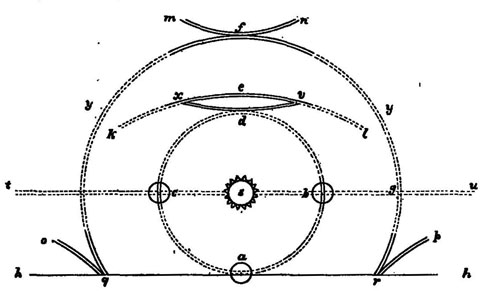
"r p, q o, arches of large circles, very strongly prismatic, which could
only be traced to p and o; but on that part of the horizontal circle
t u, which was directly opposite to the sun, there appeared a confused
white light, which had occasionally the appearance of being caused
by the intersection of large arches coinciding with a prolongation of
r p, and q o."
Possibly there were traces of the white arcs from column crystals, which caused the occasional impression of anthelion being caused by the extension of infralateral arcs (r p, q o). At least later these faint white arcs became so clear as to make further note of them:
"At 90° from the sun, on each side of it, and at an altitude of
30° to 50°, there now appeared also a very faint arch of white light,
which sometimes seemed to form a part of the circles q o, r p; and
sometimes we thought they turned the opposite way."
Subhelic arc coincides with 46° infralateral arc at the drawing's sun elevation. Most likely, however, there were other arcs as well, Wegener and helic arc, which added to the confusion. And finally, also 46° Parry arcs were observed:
"In the outer large circle, we now observed two opposite and
corresponding spotsonding spots y y, more strongly prismatic
than the rest..."
The halos were seen in Canada's Melville Island on 9 April 1820. The display was long lasting; from 1 at least until 6 pm. Observers paid also attention to sun elevation depended changes in the halos by noting the growing distance between upper tanget arc and Parry arc and the shape change in tangent arc. The excerpts of the observational account are taken from Hasting's "A general theory of halos" ( 1 )
2008. május 30., péntek
Subhelic arc in Finland

A halo display was observed on 28 May 2008 in Oulu, Finland. It was reported even by local newspaper Kaleva and some photos sent by readers were published - see 29.5.2008 photos ( 1 ). According to those photos, the display did have a very strong and colorful supralateral arc with great circumzenith arc in the earlier stage.
First photos were reported an hour earlier than I noticed the display. When I was outside the display was not very bright anymore ( 2 ).
Soon a faint white arc got my attention at atzimut around 100 degrees and high above horizon. It was first faint and hard to see and it also disappeared for a moment. Toward the end of the display, the arc got better intensity and lenght. The halo was a subhelic arc from column oriented ice crystals. An arc located this way could be also be a heliac arc, but no halos related to Parry orientation was seen. Subhelic arc was already visible as a faint and short arc in some photos which I took before I noticed the arc.
2008. május 29., csütörtök
An old halo book available
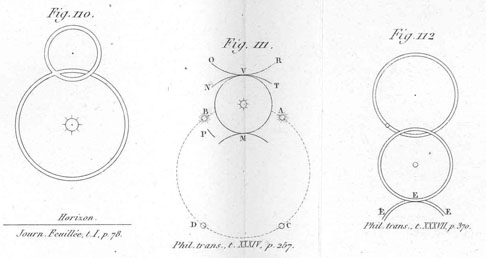
The displays in the image above are from the book. On the left is the observation by Feuillee, from which the observer name for 35° halo was derived.
In the document are also two other articles by Bravais. First one, starting from pdf page 87 is of various parhelia and second one on page 105 seems to be about fogbow.
2008. május 27., kedd
Halo winter in Rovaniemi
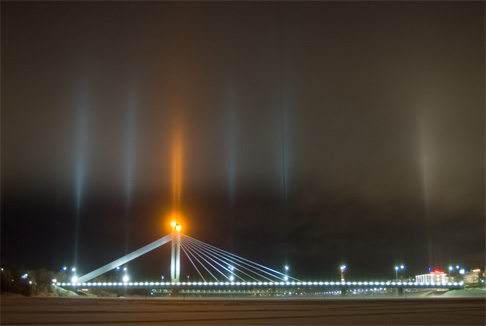
Sun pillar Intensity threshold
Halo displays created with a bright lamp seem to commonly exhibit a distinct intensity treshold at the zenith. This treshold is especially prominent in the photo above, taken on 13 December 2007 in Pälkäne, Finland as well as in Jukka Ruoskanen's images from Hyvinkää during the same night ( 1 ). The effect is also seen in the photos from Rovaniemi in early November 2007 ( 2 ). In all these displays the crystal swarm originated from the snow guns of a nearby ski resort.
The intensity threshold cannot be adequately simulated using regular hexagonal crystals. However, when semi-triangular singly oriented columns ( 3 ) are used, the intensity threshold appears, as shown in the simulation above. Such crystals are common in snow gun displays, as is evident for example in the crystal samples of the Rovaniemi display ( 4 ). Two arrows point to almost completely triangular columns.
The simulation as well as the crystal image are made with software developed by Jukka Ruoskanen. In the simulation also random crystals were used to create the 22° halo.
The raypath for the intensity threshold is 3-5-7, which, in fact, makes it a sun pillar. A filtered simulation reveals how this sun pillar forms a huge fan shaped effect with sharp outer boundary ( 5 ). This simulation was done with a program by Mika Sillanpää and Jarmo Moilanen.
Text: Jari Luomanen and Marko Riikonen
The intensity threshold cannot be adequately simulated using regular hexagonal crystals. However, when semi-triangular singly oriented columns ( 3 ) are used, the intensity threshold appears, as shown in the simulation above. Such crystals are common in snow gun displays, as is evident for example in the crystal samples of the Rovaniemi display ( 4 ). Two arrows point to almost completely triangular columns.
The simulation as well as the crystal image are made with software developed by Jukka Ruoskanen. In the simulation also random crystals were used to create the 22° halo.
The raypath for the intensity threshold is 3-5-7, which, in fact, makes it a sun pillar. A filtered simulation reveals how this sun pillar forms a huge fan shaped effect with sharp outer boundary ( 5 ). This simulation was done with a program by Mika Sillanpää and Jarmo Moilanen.
Text: Jari Luomanen and Marko Riikonen
Feliratkozás:
Bejegyzések (Atom)
